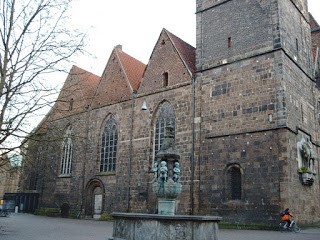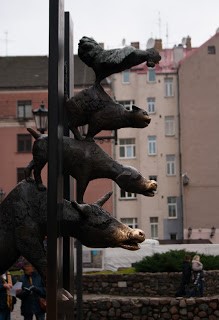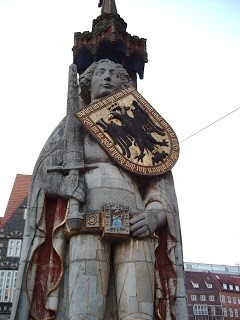City of Bremen
March 28, 2016

Diana Stanley is a Museum employee who studied abroad in Europe. She occasionally updates the blog with knowledge she gained while she traveled and explored.

The city of Bremen in Germany is a whimsical, good-humored city of the North. While it looks old, much of it is new--reconstructed after the wars. Above all, I loved Bremen’s statues which pop up unexpected in squares and on street corners. They reminded me of Wichita’s bronze artwork which stand along Douglas. The first statue stands on a corner next to the large city park, which dominates the river area. It commemorates the rebuilding effort after the war. Sixty percent of the city was bombed and 90% of the docks were destroyed.
|
|
|
The Town Musicians |
The more amusing work, The Sows by Peter Lehmann (1974) is on the corner of “Bonebreaker Street” where the butchers would live and work in the Middle Ages. A little ways on is the Cathedral of St. Peter’s or St. Petri’s Dom and the Town Hall. The next statue is between the two beautifully intact buildings. The Town Musicians (1954) has a donkey, a dog, a cat, and a rooster standing on top of each other in succession. It symbolizes a Grimm fairy tale about animals who leave their master to pursue becoming musicians in Bremen. They never actually make it to the “city of freedom” but instead have their own farm which they run themselves. The stacking of the animals comes from a scene in the tale where the animals combine their height to scare off robbers. Supposedly, if visitors grip the donkey’s forelegs and make a wish, it will come true. The Musicians inspired a saying in Bremen:
Anyone who pays taxes is an ass,
He’s on the road to ruin anyway. (going to the dogs)
Everything is in vain (German: for the cat)
And nobody cares (the cock doesn’t crow about it)
A couple hundred yards away from the Musicians is Roland, the symbolic protector of Bremen. Roland, if you know your early French literature, is the main character of the early French epic The Song of Roland, which is similar to Beowulf and the story of Siegfried. The mythical Roland was the nephew of Charlemagne. According to the story, Roland was the greatest of knights but he was betrayed when fighting the Moors.
|
|
|
Statue of "Roland" |
Bremen claims Roland was born here and as long as he stands the city will remain free. The latter was a big claim back in the day. Bremen was a member of the Hanseatic League, a group of free German city states which engaged in trade and sometimes piracy. On Roland’s Shield is the inscription in German, “To you, I reveal liberty, bestowed on this city by Charles the Great and many a prince. Thanks be to God that is my counsel.” In the Middle Ages, the distance between Roland’s armored knee spikes was called a Bremen ell. An ell was a measurement in length. Shoppers would compare fabric length to the spikes to ensure merchants were giving them the correct amount.
Bremen might not be at the top of the list for whistle stop tours of Germany, but if you have an extra day in the north it is well worth the trip. It is fairly close to the Netherlands border as a day trip. It is just large enough to be interesting, just small enough to be endearing.

